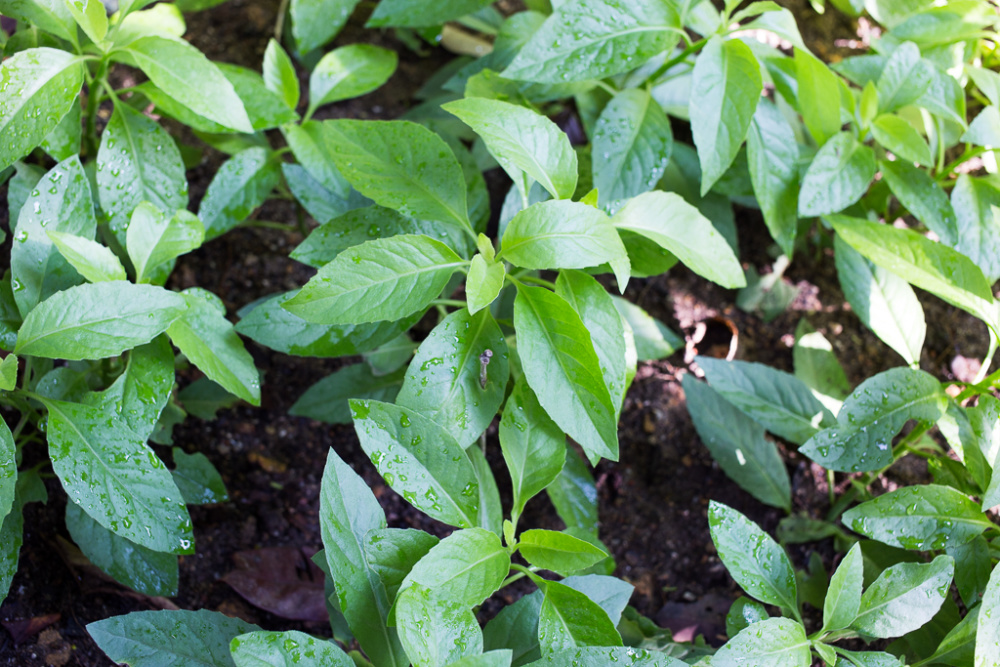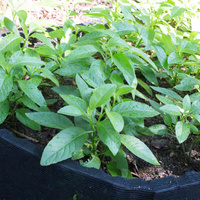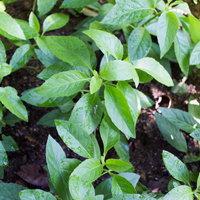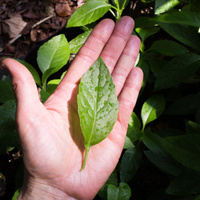Common name: Longevity spinach
Other common names: Akar, Leaves of the gods, Mollucan spinach, Sambung, Scrambling gynura, Velvet plant
Description
Longevity spinach is a leaf vegetable and medicinal herb originating in India and Southeast Asia, its natural range extending from the Himalayan foothills to southern China and the Philippines.
It is a fast-growing perennial herb or small shrub up to 0.8 m (2.6 ft) tall and is much-branched, with long stems that start erect then twine and climb up structures or creep along the ground to lengths of up to 5 m (16 ft). The new growth at the ends of stems is soft and succulent, the rest semi-woody. The bark is either green, purple or mottled.
Leaves are oval with a pointed tip, 2.5 to 7.5 cm (1 to 3 in) long, dark glossy green on top, toothed on the margins and fleshy in texture. They are alternately arranged along the stems and remain on the plant throughout the year.
Flowers are small and thistle-like with orange filaments. They are self-pollinating and come into bloom in spring, borne in loose clusters of only a few, though they are sometimes not produced. Tiny cylindrical, ribbed seed capsules follow, each containing a single seed.

Use
The leaves can be used as a spinach-type vegetable or as a raw leaf vegetable in salads. They are crisp and fleshy when raw and similar in flavour to green beans. The young and tender stem tips are also eaten, usually together with the leaves, mainly in steamed dishes. Both are added to egg dishes, curries, soups, salads and smoothies.
Longevity spinach is commonly found for sale in markets in its native region, usually in neatly tied bundles.
The plant's long stems and creeping habit lends to its cultivation as an edible groundcover.
Health use
The leaves are used in traditional medicine to treat diabetes. Only recently, laboratory tests conducted on diabetic rats have shown ethanol extracts of the leaf to exhibit significant blood glucose-lowering activity.
Climate
Grows naturally in humid subtropical and tropical climates, generally frost-free areas with annual lows of 10 to 25°C, annual highs of 20 to 35°C, annual rainfall of 1000 to 4500 and a dry season of 5 months or less.
Longevity spinach is also cultivated under irrigation in drier climates and as an annual in cooler climates.
Growing
New plants are mostly started from cuttings as seed are not always produced by the plant.
Performs best on rich, moist, free-draining sandy-loam and loamy-sand soils of a moderately acid to neutral nature, generally with a pH of 5.0 to 7.0, and on sites with partial sun or light shade exposure. It has poor tolerance to dry conditions.
Problem features
Longevity spinach is listed as a weed in at least one reference publication. It is recorded as a weed of agriculture on the island of Java in Indonesia. Still, there does not appear to be any record of it anywhere as a serious weed or invasive species.
Where it grows
References
Books
-
Martin, F. W & Ruberte, R. M. 1975, Edible leaves of the tropics, U.S. Agency for International Development (USAID), and the Agricultural Research Service, U.S. Department of Agriculture (USDA), Mayaguez, Puerto Rico
-
Randall, R. P. 2002, A global compendium of weeds, R.G. and F.J. Richardson Press, Melbourne
-
Randall, R. P. 2007, The introduced flora of Australia and its weed status, Cooperative Research Centre for Australian Weed Management, Glen Osmond, South Australia
-
Seidemann, J. 2005, World spice plants: economic usage botany taxonomy, Springer-Verlag, Berlin




